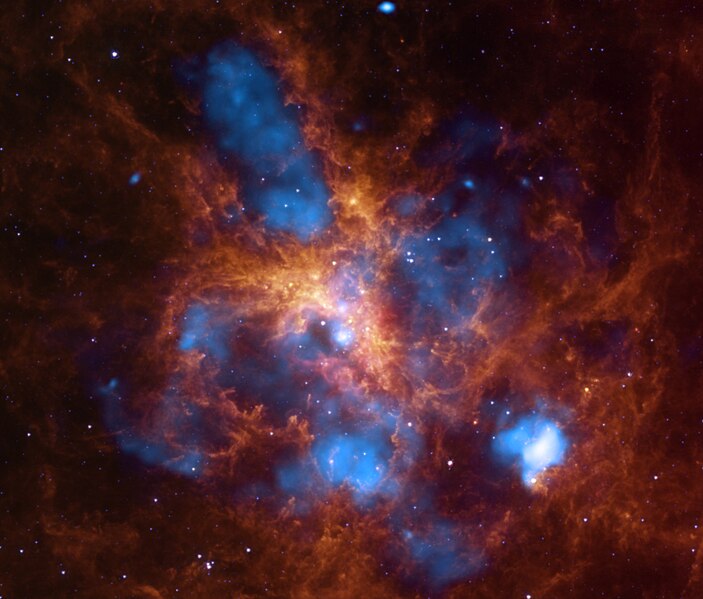File:30 Doradus - The Growing Tarantula Within.jpg

Original file (3,600 × 3,069 pixels, file size: 1.18 MB, MIME type: image/jpeg)
Captions
Captions
Summary[edit]
| Description30 Doradus - The Growing Tarantula Within.jpg |
English: The star-forming region, 30 Doradus, is one of the largest located close to the Milky Way and is found in the neighboring galaxy Large Magellanic Cloud. About 2,400 massive stars in the center of 30 Doradus, also known as the Tarantula Nebula, are producing intense radiation and powerful winds as they blow off material.
Multimillion-degree gas detected in X-rays (blue) by the Chandra X-ray Observatory comes from shock fronts -- similar to sonic booms --formed by these stellar winds and by supernova explosions. This hot gas carves out gigantic bubbles in the surrounding cooler gas and dust shown here in infrared emission from the Spitzer Space Telescope (orange). 30 Doradus is also known as an HII (pronounced "H-two") region, created when the radiation from hot, young stars strips away the electrons from neutral hydrogen atoms (HI) to form clouds of ionized hydrogen (HII). It is the most massive and largest HII region in the Local Group of galaxies, which contains the Milky Way, Andromeda and about 30 other smaller galaxies including the two Magellanic Clouds. Because of its proximity and size, 30 Doradus is an excellent target for studying the effects of massive stars on the evolution of an HII region. The Tarantula Nebula is expanding, and researchers have recently published two studies that attempt to determine what drives this growth. The most recent study concluded that the evolution and the large-scale structure of 30 Doradus is determined by the bubbles of hot, X-ray bright gas confined by surrounding gas, and that pressure from radiation generated by massive stars does not currently play an important role in shaping the overall structure. A study published earlier in 2011 came to the opposite conclusion and argued that radiation pressure is more important than pressure from hot gas in driving the evolution of 30 Doradus, especially in the central regions near the massive stars. More detailed analysis and deeper Chandra observations of 30 Doradus may help decide between these different ideas. |
| Date | |
| Source | http://chandra.harvard.edu/photo/2011/30dor/ |
| Author | X-ray: NASA/CXC/PSU/L. Townsley et al.; Infrared: NASA/JPL/PSU/L. Townsley et al. |
Licensing[edit]
| Public domainPublic domainfalsefalse |
| This file is in the public domain in the United States because it was solely created by NASA. NASA copyright policy states that "NASA material is not protected by copyright unless noted". (See Template:PD-USGov, NASA copyright policy page or JPL Image Use Policy.) |  | |
 |
Warnings:
|
File history
Click on a date/time to view the file as it appeared at that time.
| Date/Time | Thumbnail | Dimensions | User | Comment | |
|---|---|---|---|---|---|
| current | 18:58, 4 November 2013 |  | 3,600 × 3,069 (1.18 MB) | Stas1995 (talk | contribs) | User created page with UploadWizard |
You cannot overwrite this file.
File usage on Commons
The following 2 pages use this file:
File usage on other wikis
The following other wikis use this file:
- Usage on af.wikipedia.org
- Usage on de.wikipedia.org
Metadata
This file contains additional information such as Exif metadata which may have been added by the digital camera, scanner, or software program used to create or digitize it. If the file has been modified from its original state, some details such as the timestamp may not fully reflect those of the original file. The timestamp is only as accurate as the clock in the camera, and it may be completely wrong.
| Image title | About 2,400 massive stars in the center of 30 Doradus are producing intense radiation and powerful winds as they blow off material. Multimillion-degree gas detected in X-rays (blue) by the Chandra X-ray Observatory comes from shock fronts formed by these stellar winds and by supernova explosions. This hot gas carves out gigantic bubbles in the surrounding cooler gas and dust shown here in infrared emission from the Spitzer Space Telescope (orange). |
|---|---|
| Author | Chandra X-ray Observatory Center |
| Short title | 30 Doradus and The Growing Tarantula Within |
| Source | Chandra X-ray Observatory |
| Headline | A large region of star formation about 160,000 light years away in the Large Magellanic Cloud. |
| Credit/Provider | X-ray: NASA/CXC/PSU/L.Townsley e |
| Date and time of data generation | 10 November 2011 |
| Pixel composition | RGB |
| Orientation | Normal |
| Horizontal resolution | 300 dpi |
| Vertical resolution | 300 dpi |
| Software used | Adobe Photoshop CS5 Macintosh |
| File change date and time | 16:42, 29 June 2011 |
| Exif version | 2.21 |
| Color space | sRGB |
| IIM version | 2 |
| Keywords | Tarantula Nebula |